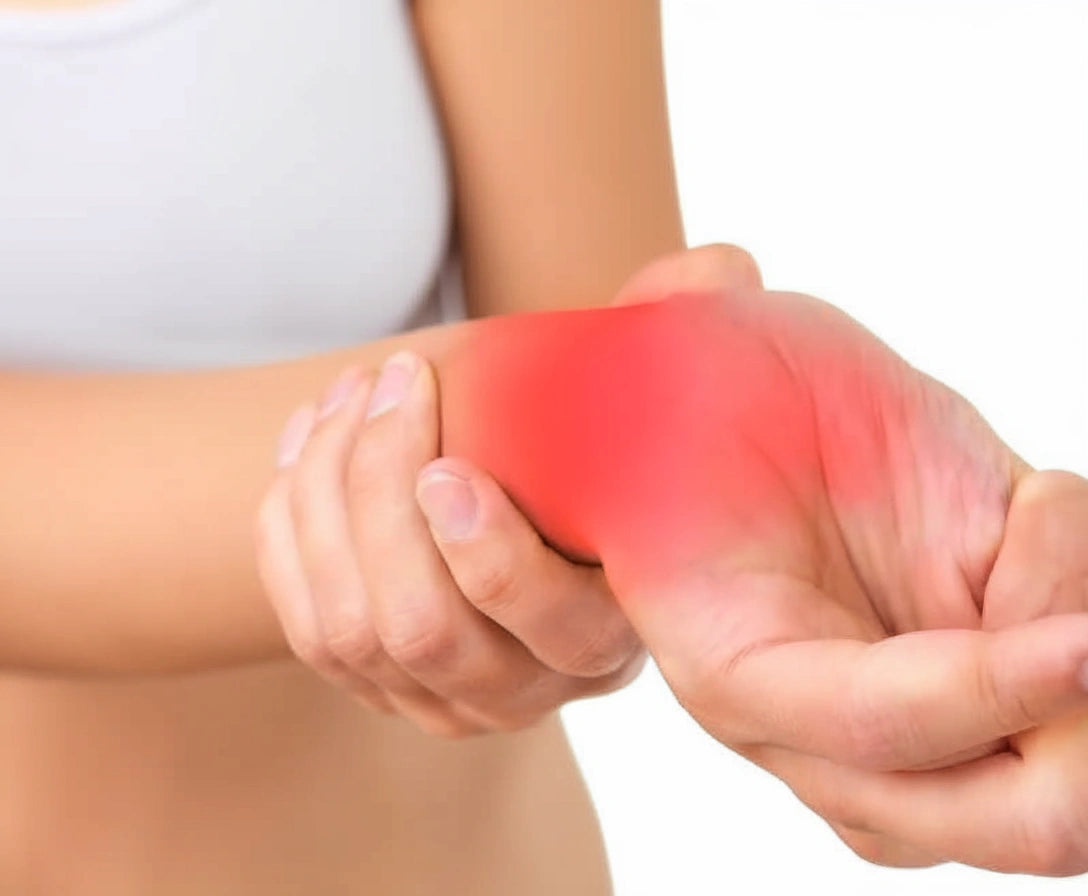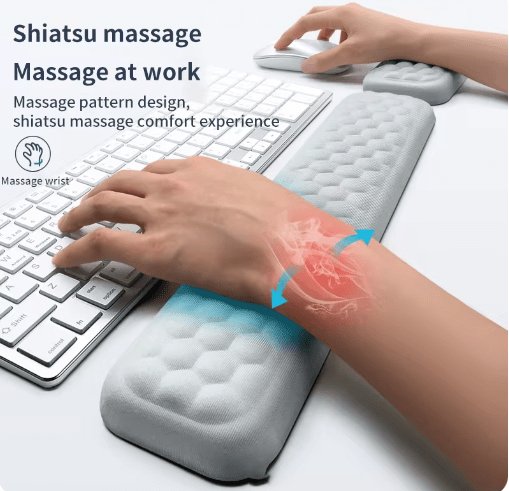Musarm (Lateral epikondylitt): Symptomer, årsaker og behandling

Tennis elbow, also known as lateral epicondylitis or tennis elbow, is a painful condition that affects the outside of the elbow and forearm. Despite the name "tennis elbow," this condition often affects people who don't play tennis. In this article, we'll go over the most common symptoms, causes, and treatment options for tennis elbow.
Definition of Mouse Arm: Answers about Mouse Arm and its Causes
Mouse arm is an overuse injury to the arm, often caused by repetitive motion. It causes pain, stiffness, and reduced function. Rest, ergonomic adjustments, and physical therapy are recommended for recovery.
The term "mouse elbow" is often used as a catch-all term for various types of repetitive strain injuries to the arm, including lateral epicondylitis, which affects the outside of the elbow. Mouse elbow is common among people who work in front of a computer, where improper mouse placement or poor posture can put strain on the tendons and nerves in the forearm. For some, the condition can progress to other conditions such as carpal tunnel syndrome , where nerves in the wrist become pinched.
Symptoms of Mouse Arm: Common Signs and Symptoms
Mouse arm often develops gradually and can vary in intensity. Common symptoms include:
- Pain on the outside of the elbow: This is often the most prominent symptom. The pain may radiate down the forearm and wrist.
- Hand and wrist weakness: You may experience difficulty gripping or lifting objects, especially with your palm facing down.
- Elbow stiffness: The joint may feel stiff, especially in the morning or after inactivity.
- Increased pain with certain activities: The pain often worsens with activities that involve twisting the forearm or bending the wrist backward.
- Tenderness to the touch: The area around the outside of the elbow may be tender to pressure.
Symptoms of mouse arm can also include numbness or altered sensation in the fingers, especially when working with the mouse for long periods of time. Many people also describe feeling tense throughout their arm, from the shoulder down to the fingers. The condition often starts as a mild ache that then becomes more intense if not treated in time. Read more about related symptoms such as tennis elbow .
Causes of Mouse Arm: Overload and Technical Risks
Several factors can contribute to the development of mouse arm:
- Overuse: Repetitive movements involving the wrist and forearm are the most common cause.
- Occupation or hobby: People who work with computers, musicians, painters, and others who perform repetitive hand movements are at higher risk.
- Age: The condition is most common among people between 30 and 50 years old.
- Incorrect technique: When playing sports or working, incorrect technique can increase the strain on the tendons.
- Weak muscles: Weakness in the forearm muscles can increase the risk of overuse injuries.
Prolonged computer work with incorrect postures often causes mouse arm. Working with the mouse far from the body or with raised shoulders puts unnecessary strain on the tendons and muscles in the arm. An ergonomist can advise on how the workplace should be adapted to minimize strain. Using keyboard shortcuts instead of a mouse can also significantly reduce strain. In some cases, it can even lead to nerve compression in the elbow .
Diagnosis and treatment of mouse arm
Effective methods and aids
Mouse arm often occurs after repeated strain on the forearm, wrist, or elbow—common when working at a computer or performing repetitive movements. The condition causes pain, stiffness, and sometimes numbness. Early diagnosis and proper treatment can prevent long-term problems and facilitate recovery.
Rest and relief
Reducing the strain on the arm is the first step in relieving the pain. Rest gives the body time to recover and reduces the risk of further irritation.
Advantages of mouse arm elbow support: Provides stable support and reminds you to avoid overexertion during daily activities.
Physical therapy
Exercise and stretching help strengthen the muscles of the forearm and improve blood circulation.
Advantages of mouse elbow protection: Supports during exercises and promotes healing by reducing pressure on the tendons.
Anti-inflammatory medication
In cases of inflammation, over-the-counter anti-inflammatory drugs can be used temporarily to reduce pain and swelling.
Benefits of mouse elbow pads: Can reduce the need for medication by providing natural relief.
Ergonomic adjustments
A correct working posture reduces the risk of recurring problems. Adjust your chair, desk, and mouse position for greater comfort.
Advantage of mouse elbow support: Complements ergonomic improvements and provides stability during prolonged computer work.
Important to consider
Treatment focuses on reducing pain and inflammation, strengthening muscles, and improving technique to prevent recurrence.
A mouse elbow support or wrist rest can be a valuable aid during the acute phase.
The healing process can take time — avoid returning to full activity too early to reduce the risk of chronic problems.

Support and Protection: How Elbow Pads and Wrist Guards Relieve Mouse Arm Pain
The mouse elbow protector from Komforten offers several benefits for people who suffer from mouse elbow:
- Provides targeted pressure on the muscles below the elbow, which relieves the attachment of the tendons.
- Helps distribute the load over a larger surface area, reducing stress on the injured area.
- Can be used during daily activities to provide continuous support and remind you to avoid overexertion.
- Supports rehabilitation exercises and can contribute to faster recovery.
- Prevents further injury by limiting extreme movements that can aggravate the condition.
For people who must continue working despite their discomfort, a mouse elbow protector can be particularly valuable. It acts as both a physical support and a reminder to be aware of your working posture. Combined with breaks and stretching exercises, the protector can help manage the symptoms while addressing the underlying causes.
Buy nowConclusion
Mouse elbow can be a painful and frustrating condition, but with proper diagnosis and treatment, most people can experience significant improvements. By combining rest, physical therapy, and the use of supportive devices such as the Mouse Elbow Protector from Komforten, many people can effectively manage their symptoms and return to normal activities. It is important to be patient during the healing process and to work proactively to reduce the risk of relapse.
Mouse arm is often a result of modern work and lifestyle habits, but with increased awareness and preventative measures, many can avoid developing serious problems. Prioritizing ergonomics, taking regular breaks, and varying your work tasks can make a big difference to the health of your arms in the long term. Sometimes , tense shoulders and neck can also contribute to problems in the forearm and elbow.
Frequently Asked Questions (FAQ)
What is the difference between mouse elbow and tennis elbow?
Mouse elbow and tennis elbow are essentially the same condition (lateral epicondylitis). The term "tennis elbow" is often used, but the condition is also common in people who do not play tennis.
How long does it take to recover from mouse arm?
Recovery time varies, but with the right treatment, many people can see improvement within 6-12 weeks. More severe cases may take longer.
Can I continue to train with a mouse arm?
Light exercise and specific rehabilitation exercises can often be beneficial, but it is important to avoid activities that aggravate the pain. Consult a physical therapist for a customized program.
How do I use the Mouse Elbow Protector for best effect?
Use the brace as directed, usually during activities that put stress on the elbow. It should fit comfortably but not too tight.
Can mouse arm be prevented?
Yes, by using the right technique during sports and work, taking regular breaks, stretching and strengthening the forearm muscles, the risk of mouse elbow can be reduced. Using the Mouse Elbow Protector can also be preventive during risky activities.

